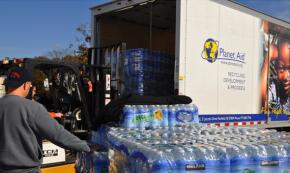What to Donate When Disaster Strikes
Used clothing donations multiply a hundred fold when tragedy strikes, far beyond the need or the capacity of relief organizations. In such situations, Planet Aid provides "secondary relief," that is: it lightens the load of organizations burdened under mounds of donated clothing. In this way the clothing is not wasted or left to rot.
When we witness people lose their homes, their possessions, and even their lives in a disaster, there are few of us who can stand idly by. We must do something, anything to help. It is particularly wrenching when tragedy strikes close to home. But as our hearts are moved to compassion, our actions should not result in empty gestures. What we do should make a difference. We should also do no harm.
An illustration of how good intentions can go awry was demonstrated in the Hurricane Sandy aftermath. People gave clothing to relief organizations en masse, and mountains of it quickly piled up, with supply far surpassing the actual meager demand.
The clothing tidal wave that came in the aftermath of Sandy reflects a larger reality of used clothing donations in the United States.
Relief organizations contacted Planet Aid for help in dealing with all the clothing. For example, a group in Jersey City had such an abundance of clothing, it filled a community swimming pool. Planet Aid was called in and retrieved almost 6,000 lbs of garments from the pool. Similarly, we sent our trucks to a small town in Virginia, where a local fire department was overwhelmed by all donated clothing. These are just two examples. National Public Radio provided further vivid examples of the deluge of donated goods.
The clothing tidal wave that came in the aftermath of Sandy reflects a larger reality of used clothing donations in the United States. As Pietra Rivoli wrote in The Travels of a T-Shirt in the Global Economy, "There are nowhere near enough poor people in America to absorb the mountains of castoffs, even if they were given away." Planet Aid is one of the few organizations that makes this reality clear to its donors and supporters. The demand or need for used clothing in the United States pales in comparison to that of developing countries. We thus send the used clothing we receive to countries where there is a real and continuous demand.
 So what should people do if they want to help? The AdCouncil has been broadcasting a public service announcement encouraging people to donate cash rather than goods to Sandy victims. It is often easier for relief agencies to buy needed items in bulk and work out special arrangements with suppliers. With such a large and complex relief operation such as Sandy, it is the most efficient and effective way to go.
So what should people do if they want to help? The AdCouncil has been broadcasting a public service announcement encouraging people to donate cash rather than goods to Sandy victims. It is often easier for relief agencies to buy needed items in bulk and work out special arrangements with suppliers. With such a large and complex relief operation such as Sandy, it is the most efficient and effective way to go.
